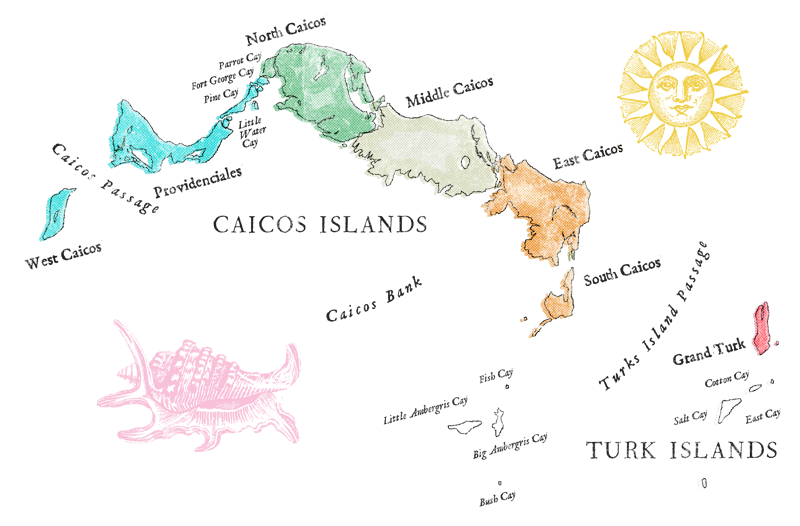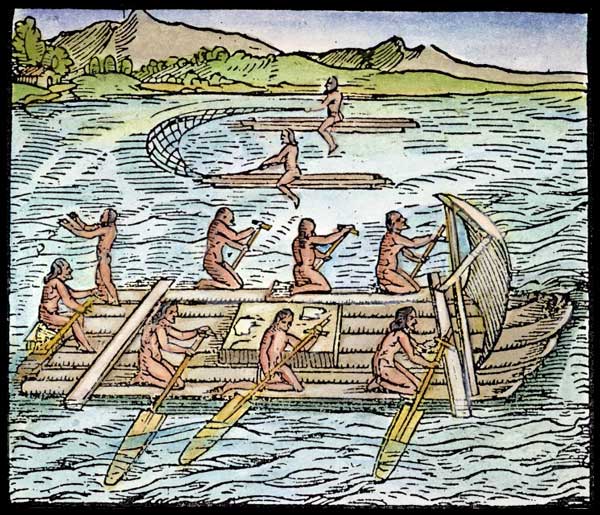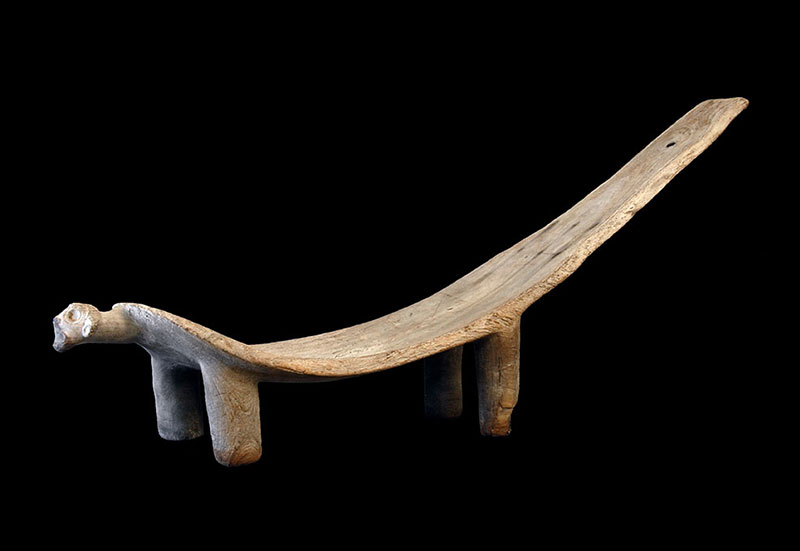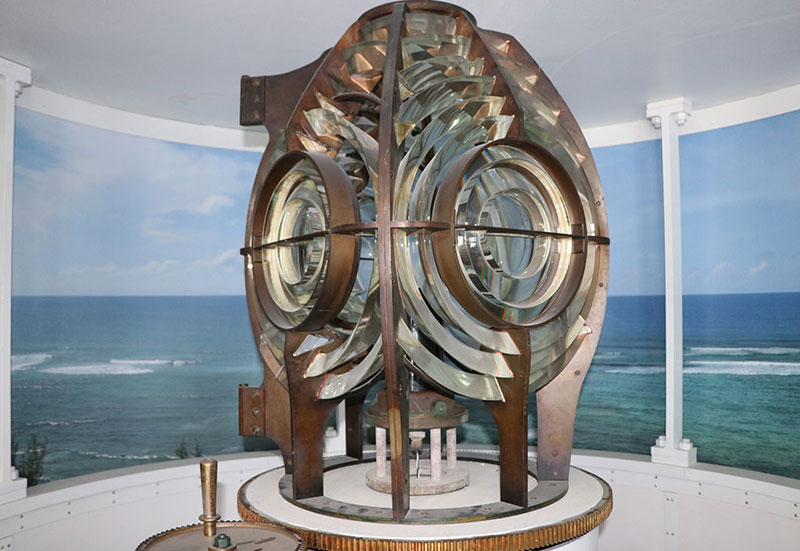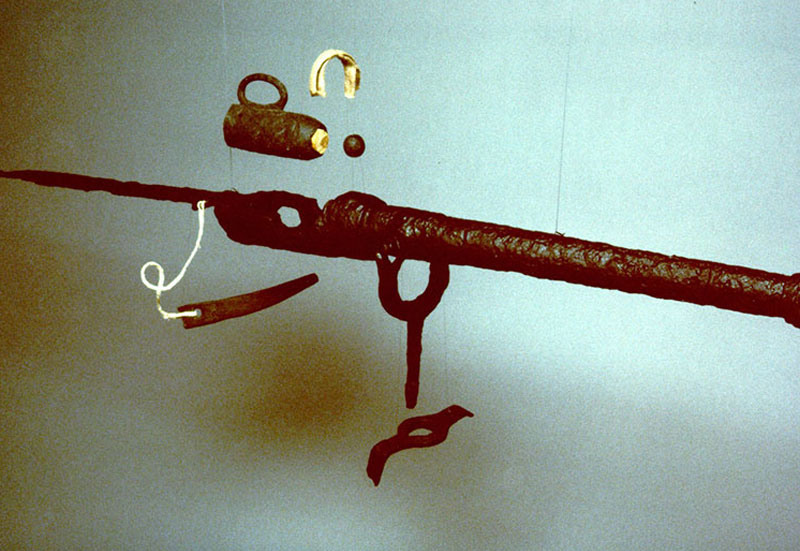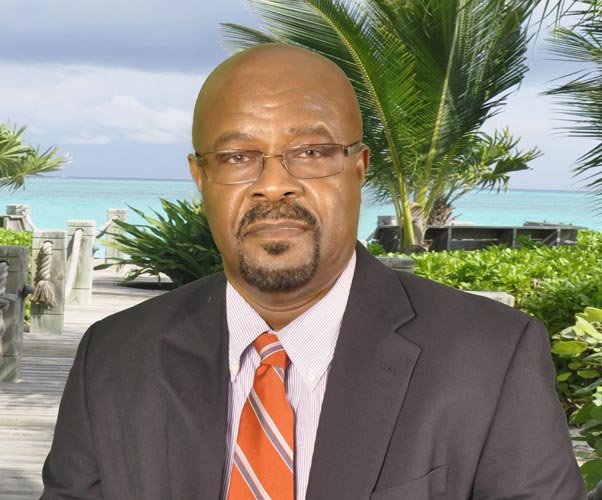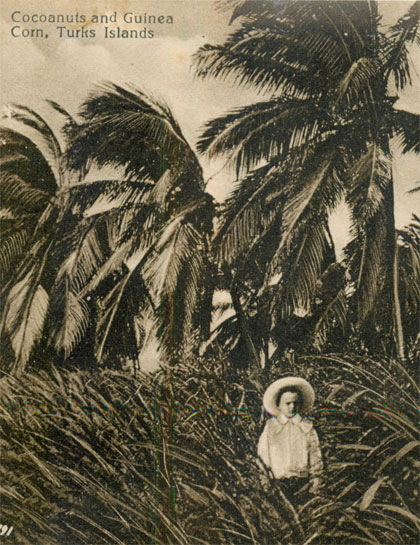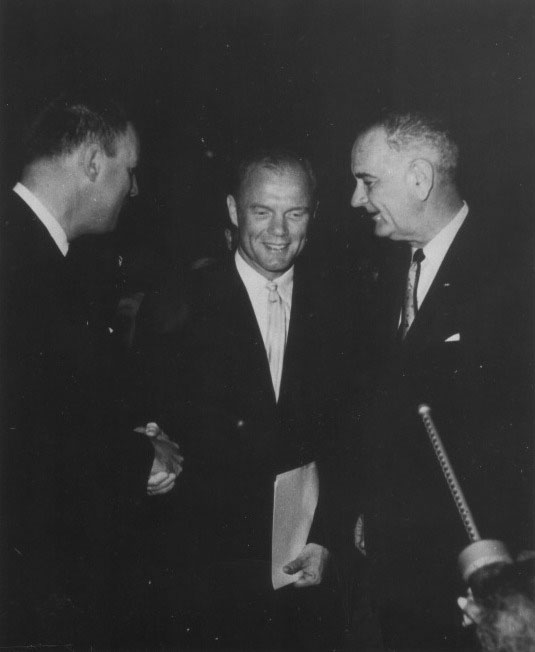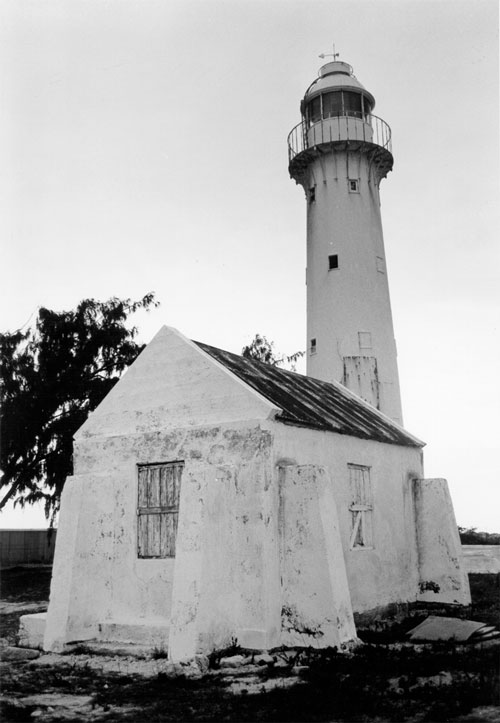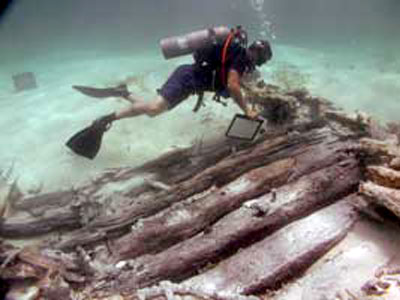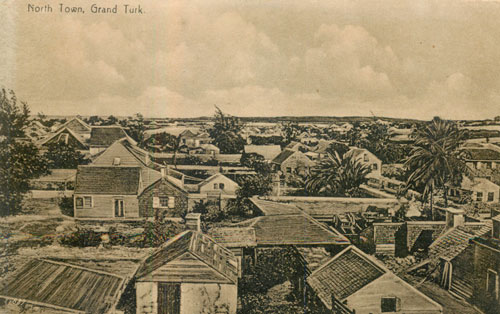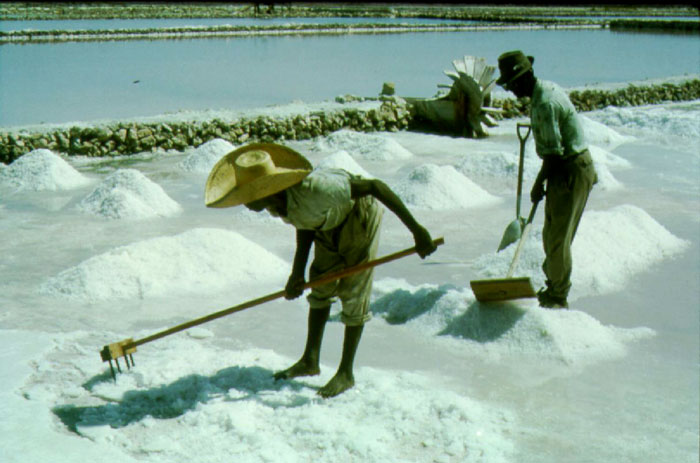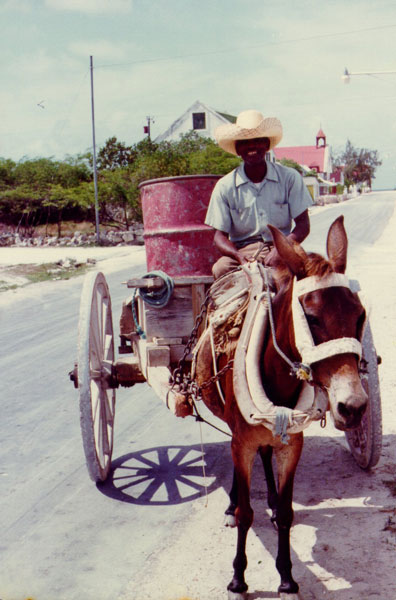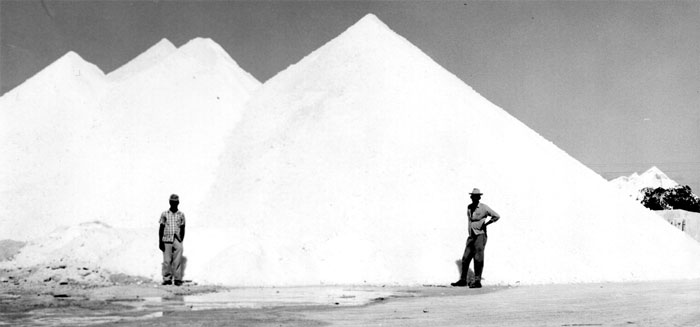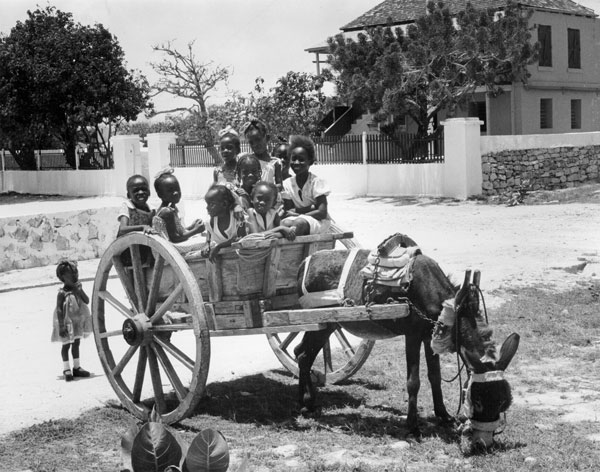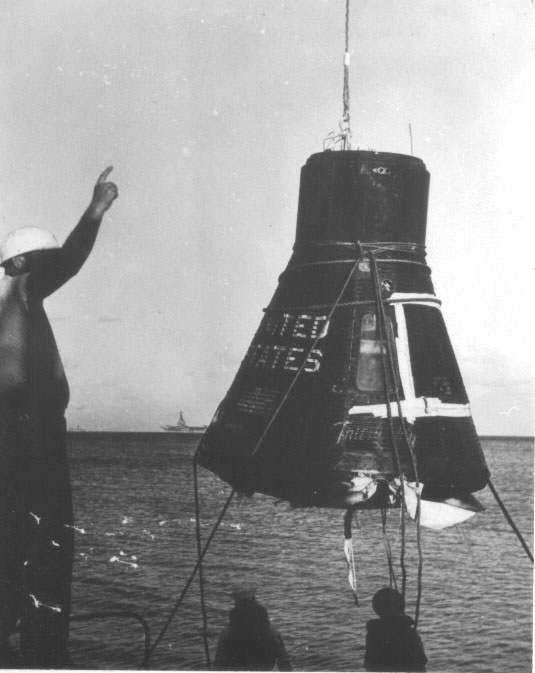Fort St George Expedition Log
By Neal Hitch
For the last five days we have been cutting paths through the bush on Pine Cay. The first paths are cut with a machete as you try and work your way into the areas that have not been explored. You have to keep your eyes open for the small things. A brick, a small ceramic fragment, or occasionally a cut foundation stone, all are indicators that this area might have been a building within the fort. When small things are found, the area is investigated. If it is determined that the area is a possible building site, a larger trail is cut back to it so that it can be measured from another known location.
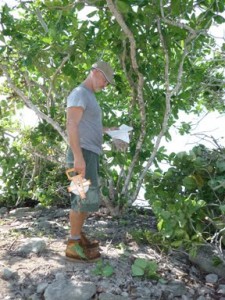 Many of the sites that have been located and documented were recorded by individuals in the 1990s. They were the real trail blazers, exploring and documenting foundations on Pine Cay in the 1990s. We have come to call them theFt.Georgians. Their records allow us a baseline to assess both erosion and degradation of the site. Locating the known sites onFt.Georgewas the first priority. We are now beginning to explore for unknown sites.
Many of the sites that have been located and documented were recorded by individuals in the 1990s. They were the real trail blazers, exploring and documenting foundations on Pine Cay in the 1990s. We have come to call them theFt.Georgians. Their records allow us a baseline to assess both erosion and degradation of the site. Locating the known sites onFt.Georgewas the first priority. We are now beginning to explore for unknown sites.
Yesterday, I came across a tree that had been blown over during the September Hurricanes. There was a piece of copper stuck in the roots. As I worked to remove the copper object I found fragments of glazed storage containers. I brought the metal detector back to the site and located several iron artifacts like brackets and nails. I then came across a pewter button with a crown in the center. Ah, a button from the coat of a regular British infantry uniform. I think I have found a building site, one that has not been located before. I cut my way out in two different directions so that we can link back to where others were working.
Today, I returned to Grand Turk to produce some maps of the areas we have been documenting. I woke up this morning with a new surprise from my trail blazing efforts yesterday. My arms are covered with Poison Wood burns. Poison Wood is a tree that is like poison ivy on steroids. Its leaves are covered with a oil produces a chemical burn when you touch it. We have been warned to look out for it. I guess I was so focused on the small stuff I neglected to look out for the big stuff. It is miserable, I must say, and I am glad I am not in the bush today.
- Published in 2009 Expedition Log
By Donald H Keith
We knew before we started that Ft St George has an underwater component as well as the walls and foundations that we are uncovering on land. People have been finding artifacts on the beach for decades and literally thousands of snorkelers have seen the cannons lying in shallow water, half buried in sand. So yesterday most of us spent 5 hours in the water combing the shallows West of Ft. George looking for clues to how much of the island—and the fort itself—have eroded into the sea. While one group concentrated on the cannons, now 50 meters offshore, Toni and Randy moved farther to the North where they bumped into a strange submerged wooden structure about 10 meters long by 6 meters wide. We still don’t know what it is: a dock? A quay of some kind? But it does seem to belong to the fort.
Being primarily an underwater archaeologist, I can’t help but wistfully reflect on how much easier it is to work underwater than on land. Underwater you never sweat. You don’t have to wear a hat and smear your body with sun block to keep skin cancer at bay. You don’t get that raging thirst that invariably accompanies hard work. There are no annoying mosquitoes or gnats hovering around your head like a curse. Your feet don’t get tired because you are essentially weightless. Not only weightless, but your buoyancy control device enables you to lift gigantic weights effortlessly. Water gives every diver super-human powers. That’s why everyone was so delighted to have a day in the water yesterday.
We are making wonderful progress in spite of the heat, humidity, and complicated logistics. I just hope we can keep it up. Yesterday morning we had an impromptu “my insect bites, coral scrapes, plant burns, scratches and rashes are worse than yours!” comparison on the beach. It was a draw between Will’s ankles and Toni’s arms.
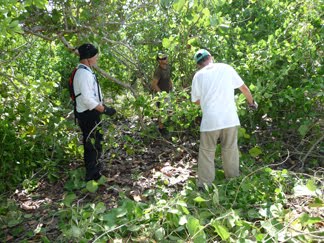 For the last three days we’ve been trying to connect three structures by clearing straight lines through the undergrowth so we can measure the exact distances between them. You can’t clear dense bush in shorts and flip-flops. The more clothes you wear the better protected you are–but it can get pretty hot and sweaty. The real, ever-present danger is dehydration and heat-related injury. We picked this time of year because it usually starts to cool off in October, but it now seems that we may have started a little too early. Yesterday it was 95 degrees and it always feels like 90 percent humidity.
For the last three days we’ve been trying to connect three structures by clearing straight lines through the undergrowth so we can measure the exact distances between them. You can’t clear dense bush in shorts and flip-flops. The more clothes you wear the better protected you are–but it can get pretty hot and sweaty. The real, ever-present danger is dehydration and heat-related injury. We picked this time of year because it usually starts to cool off in October, but it now seems that we may have started a little too early. Yesterday it was 95 degrees and it always feels like 90 percent humidity.
One of our biggest concerns is avoiding “Poison Wood” trees that grow all over the island. Robert showed us some photos he found on the internet of a poor soul who tangled with one on Grand Turk. It didn’t say whether he survived. The problem for us as we’re trying to clear tunnels through the dense bush is that they are a little tricky to identify. So far no one has encountered one (or started to show symptoms yet!), but it remains a constant source of concern. It reminds Toni and I of a plant they warned us about when we worked in Panama – “tu toca tu mata” “you touch it you die” … or wish you did.
- Published in 2009 Expedition Log
By Randy Davis, Ships of Discovery
Many people ask me what archeologists do. “Are you a treasure hunter?” Yes I am but not like most people think. My treasure and what gives the value to any object, be it a car or a piece of furniture, is the story.
Think of it like this. The treasure hunter goes down to the beach where he heard there were some golf clubs spotted. He quickly scours the area and finds 3 — a 9 iron, a 6 iron, and a 3 iron from 1954. He calls a club dealer and finds out these are worth $29 a piece—great. The archeologist, however, goes back to the site and carefully excavates the area and eventually finds a bag with several other clubs in it. He notices that the monogram on the bag is JFK. In this example, now we have a story; the real treasure and what gives value to the objects.
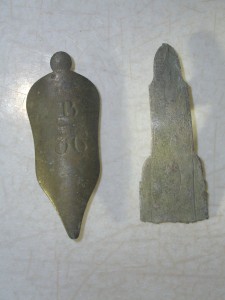 Today in the overgrowth of the original fort we found 2 pieces of what we thought were musket furniture (see image at left) —the parts of metal on the gun (see image below). At first we were not sure about them, but it had markings that if deciphered could help tell the story of Fort St. George. Now the detective work begins. It is a 200 year old CSI case.
Today in the overgrowth of the original fort we found 2 pieces of what we thought were musket furniture (see image at left) —the parts of metal on the gun (see image below). At first we were not sure about them, but it had markings that if deciphered could help tell the story of Fort St. George. Now the detective work begins. It is a 200 year old CSI case.
As soon as we got back to our quarters I reexamined the piece to see if there were any clues we overlooked in the field. Then I began a search that 30 years ago when I started in archeology could have taken 6 months. By the time you called a few people and found out who to send a picture to, developed your pictures, sent them, and they responded with a call or letter that they had no idea but they sent them to another museum curator and he would call me, it could easily be months. Today, however, with the internet, databases, E-mail, and cell phones, this process is shortened so that many of these searches can begin in the field.
 The internet search was of no help. There was nothing under musket images or general information on the web. Thankfully, an article we have from the Parks Canada was a winner. I was able to pull up weapons from a shipwreck done several decades ago that had the exact same object—a wrist escutcheon from a musket. Great! Part of the story was answered. But what did those letters and numbers mean that were on the piece? In the Canadian report it was thought that these symbols were to identify where the musket was stored. We hope there is more to it than that. An E-mail was sent to an associate that is an expert on small arms. We will continue to investigate the site and other objects until we can tell the story of Fort St. George.
The internet search was of no help. There was nothing under musket images or general information on the web. Thankfully, an article we have from the Parks Canada was a winner. I was able to pull up weapons from a shipwreck done several decades ago that had the exact same object—a wrist escutcheon from a musket. Great! Part of the story was answered. But what did those letters and numbers mean that were on the piece? In the Canadian report it was thought that these symbols were to identify where the musket was stored. We hope there is more to it than that. An E-mail was sent to an associate that is an expert on small arms. We will continue to investigate the site and other objects until we can tell the story of Fort St. George.
Meanwhile the search continues…
- Published in 2009 Expedition Log
By Robert Krieble, Ships of Discovery
As a kid I remember a dinner time conversation between my Father and Grandfather discussing the cannons off Fort George. I couldn’t believe that “real cannons” could be right there in the water across from Pine Cay and nobody had gone and taken them away. Since then I have continued to find Fort George and its famous cannons fascinating and hope in the future I will be able to show my children the cannons and fort I found so impressive as a child.
The urgent need to document and preserve this site as it literally erodes in front of our eyes is why I am very excited to be invited back to work with the museum after my initiation into archaeology on the 2008 Trouvadore expedition. With Fort George dominating the view from our house on Pine Cay, this project is truly right in my backyard. As a result of my proximity and familiarity with the island and the responsibility of arranging for transportation to the job site I have not been able to spend as much time as everyone else on Ft. George.
Instead I have had the jobs of water taxi driver, marine mechanic, carpenter and general gofer (go for this…go for that…).
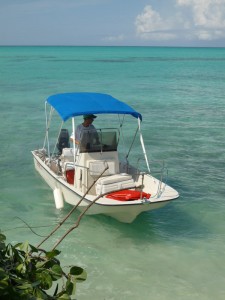 Trying to do multiple things at once makes it very easy to forget something important. We have had problems with our smaller Boston Whaler since the beginning of the trip. When cold it’s very difficult to start. As a result we drained the battery multiple times trying to start the boat. Each time we killed the battery it would go on the charger for a few hours and we would try again.
Trying to do multiple things at once makes it very easy to forget something important. We have had problems with our smaller Boston Whaler since the beginning of the trip. When cold it’s very difficult to start. As a result we drained the battery multiple times trying to start the boat. Each time we killed the battery it would go on the charger for a few hours and we would try again.
Eventually the boat is started and off we go to the site. We finish the day and I swim out to the boat and expect it will start up perfectly. Instead the battery explodes the instant I touch the key, the team on shore hears the loud bang and smoke pours out of the central console.
Luckily there was no fire and nobody was injured. We are now stranded, tired and dehydrated. The marine staff on Pine Cay was gone as was their boat. Fortunately my wife Andrea who is four months pregnant had a set of keys for the 27′ Whaler and the skill to drive it to Fort George and quickly rescue us. Our hero quickly arrives and casually tows us back home. So, from the whole team, THANKS ANDREA!
I on the other hand feel a little stupid because if I had checked the water level in the battery after charging it could have avoided the entire problem.
- Published in 2009 Expedition Log
By Neal V. Hitch, Museum Director
This was our second day on Ft George Cay. One thing is clear. There are a lot more artifacts than we thought there were.
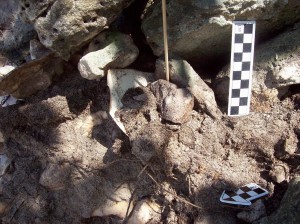 The hurricanes of last September wreaked havoc and accelerated the erosion on known foundations. We have found several ceramic artifacts in the water and in the exposed cliff where the beach is slowly claiming the fort. Many of these ceramics are the same or similar to those in the Brooke Fox collection, but being able to document similar cultural material in or around the fort foundations gives a context to interpret the artifacts that Brooke Fox donated to the museum.
The hurricanes of last September wreaked havoc and accelerated the erosion on known foundations. We have found several ceramic artifacts in the water and in the exposed cliff where the beach is slowly claiming the fort. Many of these ceramics are the same or similar to those in the Brooke Fox collection, but being able to document similar cultural material in or around the fort foundations gives a context to interpret the artifacts that Brooke Fox donated to the museum.
But, we have made more progress than we expected, and have more work cleaning and documenting artifacts than we thought we would, they are everywhere.
- Published in 2009 Expedition Log
By Donald H. Keith, Project Director
The first time I heard about Ft. George was almost exactly 18 years ago in October 1981. There was a local uproar about how a fly-by-night treasure hunting outfit called (believe it or not!) “Nomad Treasure Seekers” suddenly appeared off Ft. George Cay and started trying to raise some cannons lying in shallow water just offshore. Fortunately, Nomad’s attempted theft was thwarted by Gary Adkison, then divemaster at the Pine Cay Marina, who confronted them on site and threatened to call the Police. Gary’s saber rattling in combination with the fact that Nomad had neither the equipment nor competence to raise large cannons from chest-deep water encouraged them to move on. But as an archaeologist, I was intrigued: A “fort” in the Turks and Caicos? What did it date to? Who built it? Why was it there? Large cannons in chest deep water? How did that happen? Were they from a shipwreck or what?
 Fort George was but one of the many historical mysteries of the Turks and Caicos Islands that I was curious about, but for the next 9 years I was up to my neck in completing the excavation, conservation, and analysis of the Molasses Reef Wreck, now on exhibit in the Turks and Caicos National Museum. Finally, in 1998 my Canadian colleague Jonathan Moore and I were invited to visit Ft. George Cay with Jack McWilliams who, with other Pine Cay residents, had a long-standing interest in the site. Jon and I were fascinated by the cannons offshore, strange holes drilled into the ironshore, and carefully cut and laid stone foundations, now tumbling down from a low prominence as the sea ate away at its base. The dense bush dissuaded us from venturing inland, so we could only wonder what lay in the interior.
Fort George was but one of the many historical mysteries of the Turks and Caicos Islands that I was curious about, but for the next 9 years I was up to my neck in completing the excavation, conservation, and analysis of the Molasses Reef Wreck, now on exhibit in the Turks and Caicos National Museum. Finally, in 1998 my Canadian colleague Jonathan Moore and I were invited to visit Ft. George Cay with Jack McWilliams who, with other Pine Cay residents, had a long-standing interest in the site. Jon and I were fascinated by the cannons offshore, strange holes drilled into the ironshore, and carefully cut and laid stone foundations, now tumbling down from a low prominence as the sea ate away at its base. The dense bush dissuaded us from venturing inland, so we could only wonder what lay in the interior.The only historical information readily available about Ft. George Cay was a few short paragraphs in “Turks Islands Landfall,” a collection of brief sketches compiled by H.E. Sadler, an amateur but avid historian. He stated that Ft. George was built in 1798 by a British Army contingent in order to protect the Loyalist planters who had moved from the newly-formed United States of America to the Caicos Islands following the Revolution. Apparently, the British Army abandoned the fort a year or two later, after suffering severe losses to disease. There is no mention of any actual combat at the fort.
Now, finally, we have an opportunity to conduct the first archaeological exploration of Ft. George Cay as well as nearby Grouper Cay which is said to have similar ruins on it and may be somehow connected to the fort. Over the next two weeks our team of nine professional archaeologists and volunteers will face a challenging working environment and a tight schedule in the course of trying to answer some of the most basic questions about Ft. George: How much of it is left and how much has already been lost to erosion? Are the ruins on Grouper Cay part of the fort? Can the fort be reconstructed? How much of it is now under water?
We will focus on finding and surveying the ruins and archaeological features, rather than on excavation, which is extremely time-consuming. We will start by mapping the cannons offshore of Ft. George Cay, then connecting them with the features on shore, then moving inland to the partially-eroded foundations and onward, deeper into the island’s interior.
Over the next two weeks different members of the team will contribute their perspectives and observations to this blog, the goal of which is to share with you, the reader, events as they happen, and make you a part of the exploration and discovery experience.
- Published in 2009 Expedition Log
Ships of Discovery and the Turks & Caicos National Museum are teaming up to delve into one of the most interesting, but little known, stories in the islands. Tiny Fort St George Cay receives nearly 20,000 visitors a year, yet very little is known about the soldiers and civilians who manned the fort in the 1780s. The project to explore the island and to document the remains of the fort begins on October 23 and runs through November 6, 2009.
Stay up to date with our discoveries with the Fort St George Expedition Daily Log.
- Published in 2009 Expedition Log
- 1
- 2
